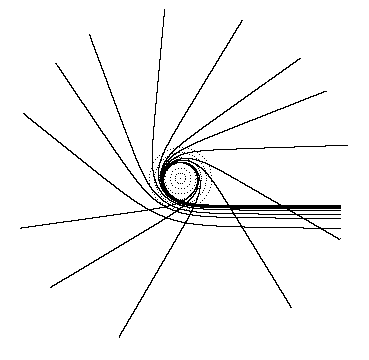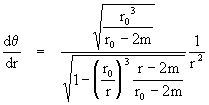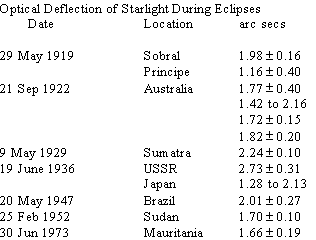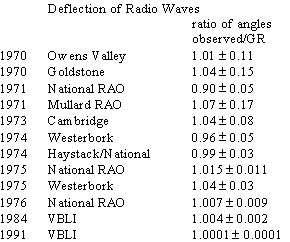At the conclusion of his treatise on Opticks in 1704, the (then) 62 year old Newton lamented that he could "not now think of taking these things into farther consideration", and contented himself with proposing a number of queries "in order to a farther search to be made by others". The very first of these was
Query 1: Do not Bodies act upon Light at a distance, and by their action bend its Rays, and is not this action strongest at the least distance?
Superficially this may not seem like a very radical suggestion, because on the basis of the corpuscular theory of light, and Newton's laws of mechanics and gravitation, it's easy to conjecture that a beam of light might be deflected slightly as it passes near a large massive body, assuming particles of light respond to gravitational acceleration similarly to particles of matter. For any conical orbit of a small test particle in a Newtonian gravitational field around a central mass m, the eccentricity is given by
![]()
where E = v2/2 - m/r is the total energy (kinetic plus potential), h = rvt is the angular momentum, v is the total speed, vt is the tangential component of the speed, and r is the radial distance from the center of the mass. Since a beam of light travels at such a high speed, it will be in a shallow hyperbolic orbit around an ordinary massive object like the Sun. Letting r0 denote the closest approach (the perihelion) of the beam to the gravitating body, at which v = vt, we have

Now we set v = 1 (the speed of light in geometric units) at the perihelion, and from the geometry of the hyperbola we know that the asymptotes make an angle of a with the axis of symmetry, where cos(a) = -1/e.

With a hyperbola as shown in the figure above, this implies that the total angular deflection of the beam of light is d = 2(a - p/2), which for small angles a and for m much less than r (in geometric units) is given by

The best natural opportunity to observe this deflection would be to look at the stars near the perimeter of the Sun during a solar eclipse. The mass of the Sun in gravitational units is about m = 1475 meters, and a beam of light just skimming past the Sun would have a closest distance equal to the Sun's radius, r = (6.95)108 meters. Therefore, the Newtonian prediction would be 0.000004245 radians, which equals 0.875 seconds of arc. (There are 2p radians per 360 degrees, each of degree representing 60 minutes of arc, and each minute represents 60 seconds of arc.)
However, there is a problematical aspect to this "Newtonian" prediction, because it's based on the assumption that particles of light can be accelerated and decelerated just like ordinary matter, and yet if this were the case, it would be difficult to explain why (in non-relativistic absolute space and time) all the light that we observe is traveling at a single characteristic speed. Admittedly if we posit that the rest mass of a particle of light is extremely small, it might be impossible to interact with such a particle without imparting to it a very high velocity, but this doesn't explain why all light seems to have precisely the same velocity, as if this particular speed is somehow a characteristic property of light. As a result of these concerns, especially as the wave conception of light began to supercede the corpuscular theory, the idea that gravity might bend light rays was largely discounted in Newtonian physics. (The same fate befell the idea of black holes, originally proposed by Mitchell based on the Newtonian escape velocity for light. Laplace also mentioned the idea in his Celestial Mechanics, but deleted it in the third edition, presumably because of the conceptual difficulties discussed here.)
The idea of bending light was revived in Einstein's 1911 paper "On the Influence of Gravitation on the Propagation of Light". Oddly enough, the quantitative prediction given in this paper for the amount of deflection of light passing near a large mass was identical to the old Newtonian prediction, d = 2m/r0. There were several attempts to measure the deflection of starlight passing close by the Sun during solar eclipses to test Einstein's prediction in the years between 1911 and 1915, but all these attempts were thwarted by cloudy skies, logistical problems, the First World War, etc. Einstein became very exasperated over the repeated failures of the experimentalists to gather any useful data, because he was eager to see his prediction corroborated, which he was certain it would be. Ironically, if any of those early experimental efforts had succeeded in collecting useful data, they would have proven Einstein wrong! It wasn't until late in 1915, as he completed the general theory, that Einstein realized his earlier prediction was incorrect, and the angular deflection should actually be twice the size he predicted in 1911. Had the World War not intervened, it's likely that Einstein would never have been able to claim the bending of light (at twice the Newtonian value) as a prediction of general relativity. At best he would have been forced to explain, after the fact, why the observed deflection was actually consistent with the completed general theory. (This would have made it somewhat similar the cosmological expansion, which would have been one of the most magnificent theoretical predictions in the history of science, but the experimentalist Hubble got there first.) Luckily for Einstein, he corrected the light-bending prediction before any expeditions succeeded in making useful observations. In 1919, after the war had ended, scientific expeditions were sent to Sobral in South America and Principe in West Africa to make observations of the solar eclipse. The reported results were angular deflections of 1.98 ▒ 0.16 and 1.61 ▒ 0.40 seconds of arc, respectively, which was taken as clear confirmation of general relativity's prediction of 1.75 seconds of arc. This success, combined with the esoteric appeal of bending light, and the romantic adventure of the eclipse expeditions themselves, contributed enormously to making Einstein a world celebrity.
One other intriguing aspect of the story, in retrospect, is the fact that there is serious doubt about whether the measurement techniques used by the 1919 expeditions were robust enough to have legitimately detected the deflections which were reported. Experimentalists must always be wary of the "Ouija board" effect, with their hands on the instruments, and knowing what results they want or expect. This makes it especially interesting to speculate on what values would have recorded if they had managed to take readings in 1914, when the expected deflection was still just 0.875 seconds of arc. (It should be mentioned that many subsequent observations have independently confirmed the angular deflection predicted by general relativity, i.e., twice the "Newtonian" value.)
To determine the relativistic prediction for the bending of light past the Sun, the conventional approach is to simply evaluate the solution of the four geodesic equations presented in Chapter 5.2, but this involves a three-dimensional manifold, with a large number of Christoffel symbols, etc. It's possible to treat the problem more easily by considering it from a two-dimensional standpoint. Recall the Schwarzschild metric in the usual polar coordinates
![]()
We'll restrict our attention to a single plane through the center of mass by setting f = 0, and since light travels along null paths, we set dt = 0, which allows us to write the remaining terms in the form
![]()
![]()
![]()
![]()
![]() (1)
(1)
This can be regarded as the (positive-definite) metric of a two-dimensional surface (r, q ), and the parameter t is the metric on this surface. Fermat's principle of "least time" implies that light follows paths that minimize the integrated time of flight (or, more generally, for which the time is stationary, as discussed in Chapter 3.5). Therefore, we need only determine the geodesic paths on this surface. The covariant and contravariant metric tensors are simply

![]()

and the only non-zero partial derivatives of the components of gmn are
![]()
![]()
![]()
![]()
so the non-zero Christoffel symbols are
![]()
![]()
![]()
![]()
![]()
Taking the coordinate time t as the path parameter (since it plays the role of the metrical distance in this geometry), the two equations for geodesic paths on the (r, q ) surface are
![]()
![]()
![]()
![]()
![]()
![]()
![]()
![]()
![]()
![]()
![]() (2)
(2)
![]()
These equations of motion describe the paths of light rays in a spherically symmetrical gravitational field, such as that surrounding the Sun. Of course, a typical star's physical radius is much greater than it's gravitational radius m, but for a theoretical "black hole" we can examine the paths of light at values of r on the same order of magnitude as m. The results are illustrated in the figure below for a set of parallel incoming rays. The dotted circles indicate radii of m, 2m, ..., 6m from the mass center. Notice that a significant fraction of the oblique incoming rays are "scattered" back out, with a loop at r = 3m, which is the "light radius". As a consequence, if we shine a broad light on a black hole, we would expect to see a "halo" of back-scattered light outlining a circle with a radius of 3m.

For a ray of light passing the Sun, the gravitational deflection is very much less than in the above figure, because the rays are passing much further way from the mass center. To assess the angular deflection in the weak field, recall that the general solution of dy/dx + f(x)y = 0 is y = Ke-ò f(x)dx where K is a constant of integration, the second geodesic equation of motion can be integrated as follows
![]()
To determine the value of K, we divide the metric by (dt)2 and evaluate it at the perihelion r = r0, where dr/dt = 0. This gives
![]()
Substituting into the previous equation we find K2 = r03/(r0 - 2m), so we have

Now we can substitute this into the metric equation (1) divided by (dt)2 and solve for dr/dt to give

Dividing dq /dt by dr/dt then gives

Integrating this from r = r0 to ź gives the mass-centered angle swept out by a photon as it moves from the perihelion out to an infinite distance. If we define r = r0/r the above equation can be written in the form

The magnitude of the second term in the right-hand square root is always less than 1 provided r0 is greater than 3m (which is the radius of light-like circular orbits, as discussed further in Chapter 6.4), so we can expand the square root into a power series in that quantity. The result is

This can be analytically integrated term by term. The integral of the first term is just p/2, as we would expect, since with a mass of m = 0 the photon would travel in a straight line, sweeping out a right angle as it moves from the perihelion to infinity. The remaining terms supply the "excess angle", which represents the angular deflection of the light ray. If m/r0 is small, only the first-order term is significant. Of course, the path of light is symmetrical about the perihelion, so the total angular deflection between the asymptotes of the incoming and outgoing rays is twice the excess of the above integral beyond p/2. Focusing on just the first order term, the deflection is therefore

Evaluating the integral

from r = 0 to 1 gives the constant factor 2, so the first-order deflection is d = 4m/r0. To higher orders in m/r0 we have

The difficulty of performing accurate measurement of optical starlight deflection during an eclipse can be gathered from the following list of results taken from Ohanian and Rufinni:

Much more accurate measurements can be made in the radio wavelengths, since it's not necessary to wait for an eclipse. The following list of experimental results, again taken from Ohanian and Rufinni, shows the ratio of observed deflections to the deflections predicted by general relativity.

The VBLI measurements are taken from several different observatories working in concert, enabling the improvement in resolving power due to the large baseline.